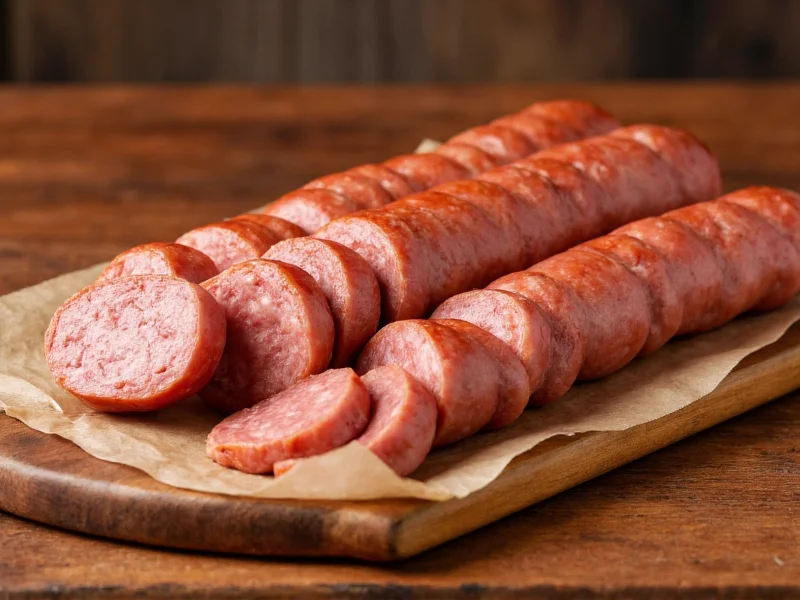Sausages represent one of humanity's oldest food preservation techniques, transforming perishable meat into a stable, transportable product through grinding, seasoning, and casing. The basic sausage formula combines protein sources with fat, salt for preservation, and flavorings that vary dramatically across cultures and regions. Understanding what sausage is requires examining its historical roots, fundamental composition, and global variations that have evolved over millennia.
Historical Origins of Sausage
The earliest evidence of sausage production dates to ancient Mesopotamia around 3000 BCE, where clay tablets describe a dish of chopped meat mixed with breadcrumbs and spices stuffed into animal intestines. Greek and Roman civilizations refined these techniques, with the Roman poet Homer mentioning "blood sausages" in the Odyssey. The word "sausage" itself derives from the Latin "salsus," meaning "salted," highlighting salt's critical role in preservation before refrigeration.
Key Milestones in Sausage Evolution
- 4th millennium BCE: Earliest evidence from Mesopotamian clay tablets describing meat-stuffed intestines. Verified through archaeological analysis at Uruk. Source: University of Pennsylvania Museum of Archaeology and Anthropology
- 8th century BCE: Homer's Odyssey documents blood sausages in ancient Greece, indicating established culinary traditions. Source: Perseus Digital Library, Tufts University
- 1st century CE: Roman cookbook De Re Coquinaria records 11 distinct sausage recipes, including liver and blood varieties. Source: University of Chicago Library
- 15th century: Term "sausage" enters Middle English from Old North French, cementing its linguistic evolution. Source: Online Etymology Dictionary
Core Components of Traditional Sausage
All sausages share three fundamental elements regardless of regional variations:
- Protein base - Typically pork, beef, poultry, or game, though vegetarian options use plant proteins
- Fat content - Essential for moisture and flavor (usually 20-30% of mixture)
- Seasonings and preservatives - Salt, spices, herbs, and sometimes curing agents like nitrites
The casing serves both functional and traditional purposes, containing the mixture during cooking while allowing smoke and heat penetration. Natural casings from animal intestines provide superior texture and cooking properties compared to synthetic alternatives.
Global Sausage Varieties Compared
| Type | Region | Key Characteristics | Preparation Method |
|---|---|---|---|
| Bratwurst | Germany | Pork or veal with nutmeg, ginger, cardamom | Grilled or pan-fried |
| Chorizo | Spain/Latin America | Paprika, garlic, vinegar; cured or fresh | Dry-cured or cooked fresh |
| Italian Sausage | Italy/US | Fennel, garlic, red pepper flakes | Fresh, rarely smoked |
| Andouille | France/Louisiana | Pepper, wine, double-smoked | Smoked and cured |
| Blood Sausage | Global | Animal blood, fat, grains | Boiled then fried |
Contextual Limitations and Appropriate Usage
Sausages have specific constraints affecting preparation, consumption, and cultural acceptance:
- Religious dietary compliance: Pork-based sausages are prohibited in Islam and Judaism. Halal alternatives require USDA-certified beef processing under Islamic supervision, while kosher varieties use beef/poultry with rabbinical certification. Source: USDA Food Safety and Inspection Service
- Health considerations: WHO classifies processed meats as Group 1 carcinogens, associating >50g daily consumption with 18% increased colorectal cancer risk. Consumption should be limited to <500g weekly. Source: International Agency for Research on Cancer
- Storage requirements: Fresh sausages require refrigeration below 40°F (4°C) with 1-2 day shelf life, while cured varieties need humidity-controlled environments below 55°F (13°C) to prevent spoilage. Source: USDA Food Safety Guidelines
Modern Sausage Production Methods
Contemporary sausage manufacturing maintains traditional principles while incorporating food safety standards. The process begins with precise meat-to-fat ratios ground at controlled temperatures to prevent fat smearing. Seasonings get thoroughly mixed before stuffing into casings using vacuum-assisted machines that eliminate air pockets. Most commercial sausages undergo strict pathogen testing, with cured varieties containing regulated amounts of sodium nitrite to prevent botulism while developing characteristic flavor and pink color.
Artisanal producers often follow more traditional methods, using coarser grinds, natural casings, and longer curing periods that develop complex flavors through enzymatic action. The growing craft sausage movement emphasizes heritage breeds, locally sourced ingredients, and traditional spice blends that reflect regional culinary identities.
Cultural Significance of Sausage Worldwide
Sausages serve as culinary ambassadors of cultural identity. Germany's Oktoberfest celebrates bratwurst as national heritage, while Spain's chorizo represents regional diversity through varying paprika types and curing methods. In the American South, smoked sausages feature prominently in Cajun and Creole cuisine, reflecting French and Spanish influences. Many cultures incorporate sausages into religious festivals and seasonal celebrations, connecting food traditions to communal identity.
Understanding what sausage is means recognizing its role beyond mere sustenance—it represents human ingenuity in food preservation, cultural adaptation, and culinary expression. From ancient preservation technique to modern gourmet ingredient, sausage continues evolving while maintaining its fundamental identity as seasoned, stuffed meat.











 浙公网安备
33010002000092号
浙公网安备
33010002000092号 浙B2-20120091-4
浙B2-20120091-4